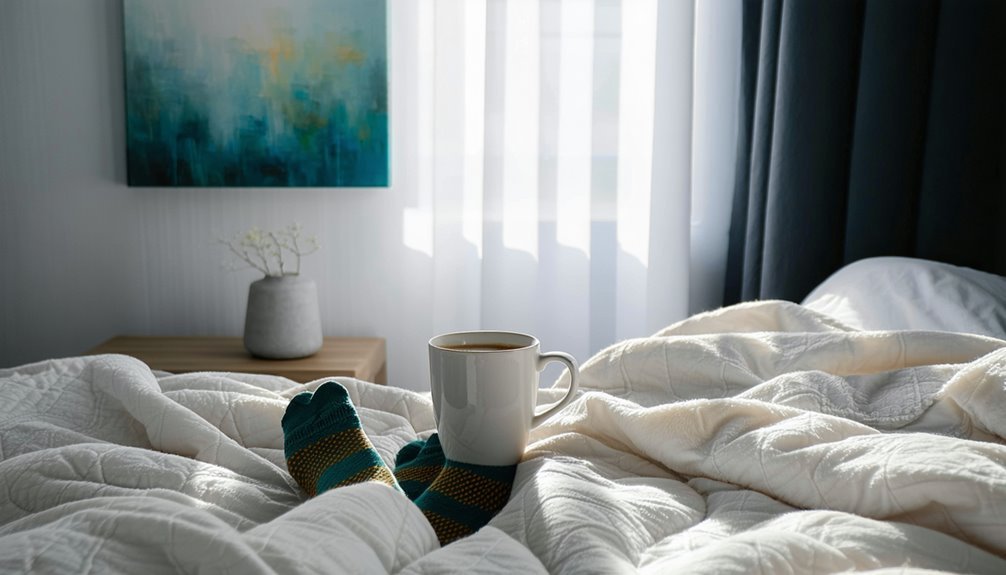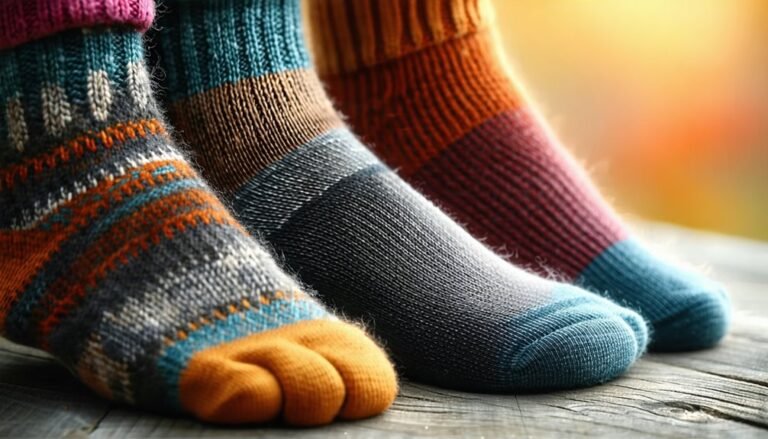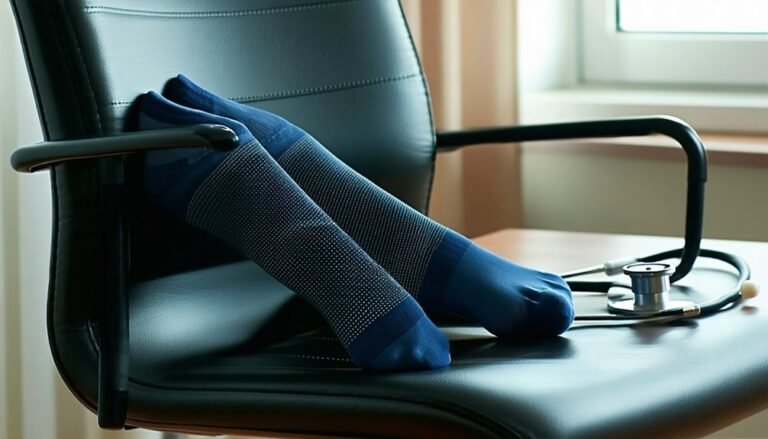Can You Wear Compression Socks to Bed?
Wearing compression socks to bed can be beneficial for venous issues, promoting circulation and reducing edema. However, it is essential to guarantee a proper fit to avoid compromising blood flow. Those with conditions like peripheral artery disease, congestive heart failure, or diabetic neuropathy should avoid nighttime use due to increased risks. Consultation with healthcare professionals is recommended. To understand the full range of considerations and recommendations, further exploration into their use might be insightful.
Understanding Compression Socks and Their Purpose
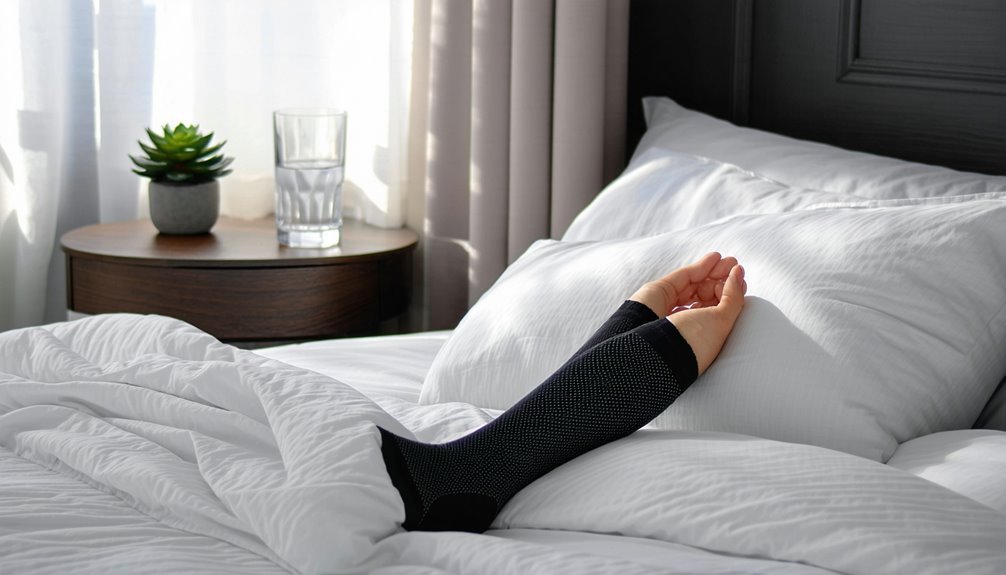
Compression socks, often regarded as a therapeutic tool, are designed to apply gentle pressure to your legs, promoting blood circulation and reducing venous pressure. Various compression sock types exist, including graduated compression and anti-embolism stockings, each serving specific medical needs. Understanding these variations guarantees you select the appropriate type for your condition, enhancing efficacy and safety.
A proper fit is essential; incorrect sizing can negate benefits or cause discomfort. To guarantee a proper fit, measure your leg circumference and length accurately, consulting size charts for guidance. Evidence-based studies demonstrate that when fitted correctly, compression socks can help manage conditions like chronic venous insufficiency. Prioritize your safety by consulting healthcare professionals to choose the ideal compression sock type and fit for your needs.
Potential Benefits of Wearing Compression Socks at Night
While not universally recommended for everyone, wearing compression socks at night might offer certain therapeutic advantages, particularly for individuals with specific medical conditions. Evidence suggests that nighttime use can promote improved circulation, potentially alleviating symptoms associated with chronic venous insufficiency. This enhanced blood flow may lead to reduced swelling and decreased discomfort in the lower extremities.
Consider these benefits:
| Benefit | Description | Population |
|---|---|---|
| Improved Circulation | Enhances venous return | Those with venous issues |
| Reduced Swelling | Minimizes edema | Individuals with edema |
| Comfort Enhancement | Eases nocturnal leg pain | Patients with leg pain |
For those diagnosed with conditions like edema or varicose veins, incorporating compression therapy during rest might aid in maintaining vascular health. Always consult a healthcare professional to ascertain it's a safe choice for you.
Risks and Considerations for Nighttime Use
Although wearing compression socks at night might offer certain benefits, it's important to evaluate the potential risks and contraindications associated with their use during sleep. One primary consideration is nighttime comfort. Compression socks, if too tight, may impede restful sleep or cause discomfort. It's imperative to confirm they fit properly to avoid exacerbating any discomfort. Additionally, circulation concerns should be addressed. While compression socks are designed to enhance venous return, improper use can lead to restricted blood flow, potentially resulting in adverse effects. Consequently, it's critical to be aware of any underlying vascular conditions that might worsen with nighttime use. Consulting with a healthcare professional can help determine the appropriate compression level and guarantee safe use tailored to your individual needs.
Who Should Avoid Wearing Compression Socks to Bed?
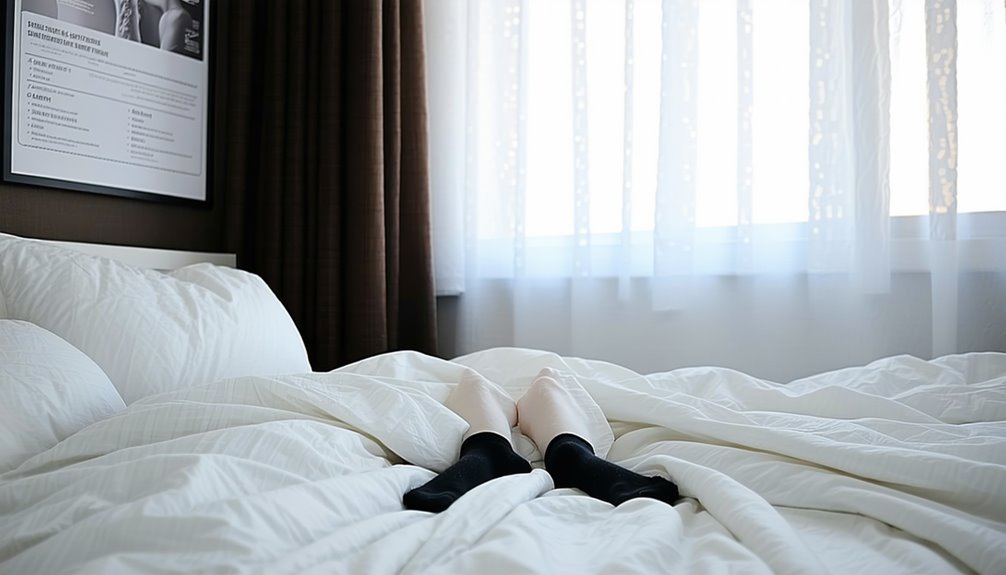
If you're considering wearing compression socks to bed, it's crucial to understand that certain individuals should avoid this practice due to potential health risks. People with pre-existing medical conditions, particularly those affecting circulation, should exercise caution. Individuals with severe peripheral artery disease, for example, may experience exacerbated circulation issues when using compression socks overnight. Additionally, those with congestive heart failure might face increased fluid retention, worsening their condition. It's also advisable for diabetic patients with neuropathy or compromised skin integrity to avoid wearing these socks to bed, as they can unknowingly cause pressure sores. Always consult with a healthcare professional to evaluate your specific medical conditions before integrating compression socks into your nighttime routine. Prioritizing safety is paramount to maintaining ideal health.
Tips for Safely Incorporating Compression Socks Into Your Sleep Routine
To safely incorporate compression socks into your sleep routine, it's essential to adhere to evidence-based guidelines that promote both comfort and health. Selecting the right sock materials enhances sleep comfort and minimizes any potential risk. Begin by evaluating your specific medical needs; consult a healthcare professional to determine appropriate compression levels.
Consider these tips:
- Choose breathable sock materials: Opt for fabrics like cotton or merino wool to maintain ideal temperature regulation during sleep.
- Monitor for adverse reactions: Check for signs of skin irritation or discomfort, and discontinue use if necessary.
- Start with short duration: Gradually increase wear time to allow your body to adjust comfortably.
Frequently Asked Questions
Can Compression Socks Improve Sleep Quality for People Without Circulation Issues?
You might not experience significant sleep benefits from compression socks without circulation issues. Clinical evidence suggests they can slightly affect comfort levels, but their impact on overall sleep quality remains minimal. Prioritize safety and consult a healthcare professional.
Do Different Materials of Compression Socks Affect Their Suitability for Nighttime Use?
When considering nighttime use, material comfort and fabric breathability are essential. Different sock materials alter air permeability and moisture-wicking capabilities, affecting thermal regulation. Choose materials clinically proven to support skin health and prevent adverse dermatological reactions.
Are There Specific Brands Recommended for Wearing Compression Socks to Bed?
When considering brand comparisons for nighttime compression socks, you'll find popular options like Sigvaris and Jobst. Clinical evidence suggests they're safe choices, prioritizing comfort and medically proven efficacy, ensuring reduced risk of complications while sleeping.
How Do You Determine the Right Size of Compression Socks for Sleeping?
To guarantee a secure sock fit, start with size measurement. Measure your calf's circumference and length, then consult clinical charts. Evidence-based guidelines guarantee safety, preventing compression complications and guaranteeing your compression socks support without squeezing excessively.
Can Compression Socks Be Worn With Other Sleep Aids or Nighttime Attire?
You can combine compression socks with other sleep accessories for enhanced nighttime comfort. However, consult a healthcare provider to verify it's safe, as contraindications with certain medical conditions could impede circulation, affecting your overall sleep quality and safety.

